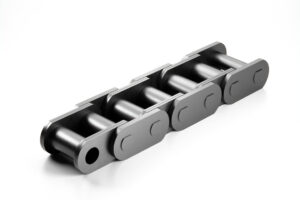BUSH CHAINS (DIN 8164 )

A bush chain is a type of low-speed fixed chain that lacks the roller. These chains are not suitable for high peripheral speeds. The purpose of having a bush chain is to make the drive more efficient and reduce friction. If there needs to be little power to move heavy loads, the chances are a bush chain is being used in the facility.
A bush chain uses a series of rollers to transfer power from one pulley to another, which helps increase efficiency and reduce friction by eliminating the need for a roller’s friction. Sometimes they need a sprocket chain to equalize the pressure of transfer actions. Discover more on bush chains here!
What is a Bush Chain?
Bush chains have a similar structure to roller chains, but they lack the roller. One can also refer to them as transfer chain due to their application area, where power is transferred by the means of them. In this sense, axle is connected to a connecting device (or “bush”) on each side of the vehicle’s frame.
Therefore, maintenance of fixed bush chains is important because all chain parts should be inspected and lubricated as needed.
Lack of lubrication causes the chain to fail in a short time. Lubrication will help keep the bushings in proper working order by keeping them well-oiled so they can function properly. If the bushings become dry or stiff, they will not be able to do their job when you need them to.
What is Bush Chain used for?
Bush chains play a critical role, especially in heavy industry and machinery manufacturing. These chains are formed by assembling parts made of high-strength steel and are mainly used in applications requiring high load capacity. Bush chains manufactured in accordance with DIN 8164 standards are widely preferred especially in industrial machinery, conveyor systems and energy transmission systems.
Durability, one of the most important features of industrial chains, is at the highest level in bushing chains. Their resistance to high stress and impact conditions makes them indispensable for sectors such as mining, construction and heavy industry. They also play a major role in reducing operating costs thanks to their low maintenance requirements.
Another important advantage of bush chains is their flexibility. Their ability to adapt to varying load conditions allows them to be easily used in different mechanical assemblies. This is especially important in automation systems and continuous production facilities.
Bush chains, known for their reliability, offer all these advantages at the maximum level when manufactured in accordance with DIN 8164 standards. These standards specify the dimensions and tolerances of the chains, ensuring a globally recognized standard of quality and performance.
In conclusion, bush chains are the key to power transmission in the industrial world. Characterized by their durability and low maintenance requirements, these chains have a wide range of applications from heavy industry to automation. Systems using these chains operate uninterruptedly and reliably, increasing the efficiency of production processes and contributing to operational success.
Usage Areas of Bush Chains
The bush chain has many different applications. Because it is designed with a robust design, it is often used as a slow-running drive and conveyor chain under heavy operating conditions. It is mostly used in the mining industry (generally with scraper chains) or construction site equipment.
The fixed bush chain can be used to operate machinery and equipment that needs to withstand high amounts of stress and pressure. They are used in applications like mining and construction sites in order to lift heavy loads without causing damage to the machine or equipment itself. This makes them an excellent choice for heavy duty usage areas where there are many moving parts involved with each operation being carried out by these chains.
These chains are known to withstand high levels of temperatures and keep their effectiveness at the same time. As a result, high temperature applications are a common area of usage for these special chains.
Bush Chains Features
Bushing chains are specialized types of chains designed for power transmission in industrial applications. These chains consist of a series of bushes formed by interconnected links. The bushings increase the strength of the chain while reducing wear and tear. They also allow the chain to run more quietly during movement, making them ideal for noise-sensitive working environments.
Bush chains manufactured in accordance with DIN 8164 have specific dimensional and tolerance specifications. These standards maximize the functionality and life of the chain. The standards cover the dimensions of the chains, pin diameters, internal and external width dimensions and bush diameters. These dimensions directly affect the load capacity and durability of the chain.
Another important feature of bush chains is their high load capacity. Manufactured from high-strength steel, these chains are known for their capacity to carry heavy loads. This is especially important in heavy industrial machinery, mining equipment and high capacity transportation systems.
In addition, bush chains are characterized by their low maintenance requirements. Because they are made from high-quality materials, wear and tear is minimal, even over long periods of use. This reduces operating costs and provides continuity benefits.
As a result, bush chains are indispensable elements for industrial applications with their durability, high load capacity, low maintenance and quiet operation. Manufactured in accordance with DIN 8164 standards, these chains offer reliability and performance at global industry standards. The choice of these chains contributes significantly to operational success by increasing the efficiency of machines and transportation systems.
2024 Bush Chains Prices
In 2024, the prices of bush chains will fluctuate depending on several important factors. These factors include the cost of raw materials, developments in production technologies and international trade policies. Price fluctuations in world markets, especially for basic raw materials such as steel, have a direct impact on the end consumer prices of bushing chains.
Characteristics such as the type and size of the chain produced also play a decisive role in the pricing of bushing chains. For example, larger and more durable chains designed for heavy industrial applications can be more costly. At the same time, chains manufactured in accordance with specific standards, such as DIN 8164, may have a higher price tag due to the additional manufacturing processes required to comply with these standards.
In 2024, another important factor in the price of bush chains is technological innovation. New technologies used in manufacturing processes can improve the quality and durability of chains while reducing production costs. This could result in cost savings for consumers in the long run, which could affect the market price of the product.
Global economic conditions and exchange rate fluctuations are also among the factors affecting the prices of bush chains. In particular, the prices of imported chains are directly related to the value of the local currency.
As a result, prices of bush chains in 2024 vary depending on various factors such as raw material costs, production technologies, international trade policies and economic conditions. These prices constitute a significant cost item for both industrial users and consumers and directly affect their purchasing decisions.
Contact us for your needs now! You can examine the “MAKELSAN CUSTOM MADE CHAINS CATALOG” for more detailed information about the fixed bush chains that we manufacture!
Bush Chains FAQ
Bush chains deliver advantages in a number of ways. For instance, they operate at a higher speed than belt drives on inclines and in facilities where temperature, humidity, or other elements would affect their performance. Other advantages include their ability to be lubrication-free.
Bush conveyor chains can offer a number of advantages over belt drive conveyor chains in certain situations. For example, bush chain conveyors are often capable of moving loads at a faster rate and on steeper inclines than belt drives, which can be useful in a number of different facilities. Bush chain conveyors are also known for their quiet operation and ability to move materials without the regular need for re-lubrication, which can lead to long-term expense reduction for businesses.
Bush chains are ideal for use in heavy-duty applications. Pneumatic systems, hydraulic systems, and electric motors are just a couple examples of where these types of chains are used.
Because of their robust design, fixed bush chains are often used as the slow-running drive and conveyor chains under heavy operating conditions.
Solid bush chains are often used in heavy loads as fixed bush chains because of their robust design and low cost. Bush chains are commonly used to slow down the speed of a conveyor or drive chain under heavy operating conditions. They are most commonly used in the mining industry and construction site equipment, where they are required to withstand high loads and temperatures.
Harsh environments are very common when it comes to usage areas of bush chains as it helps increase the effectiveness of performance. A belt drive can be used in wet or humid environments, but chain drives have advantages in conditions like temperature and humidity. Belt drives are more susceptible to damage in these conditions, while chain drives are more resistant. Bush chains are also quieter than belt drives, so they can be used in difficult facilities with noise restrictions.


